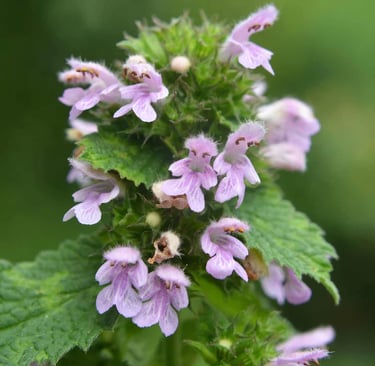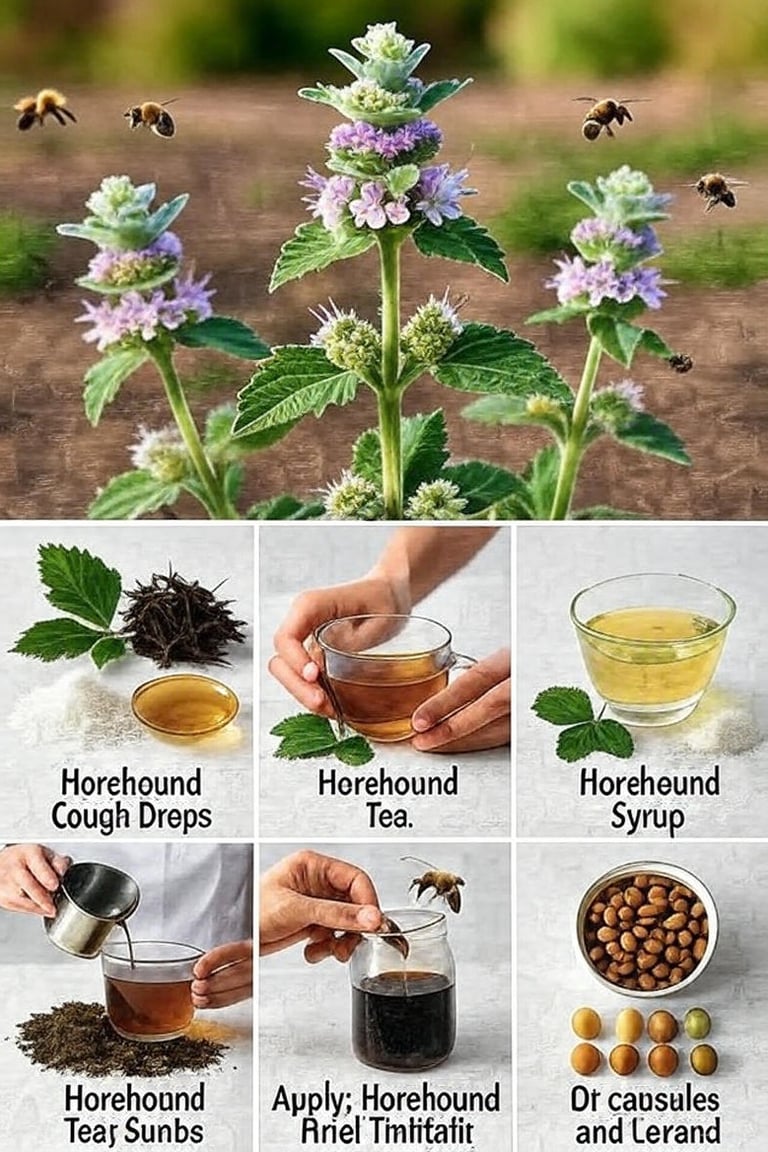Unlocking the Power of Horehound: Nature's Bitter Herb for Respiratory Relief and Beyond
Welcome to this deep dive into horehound, an ancient herb that's been a staple in traditional medicine for centuries. If you're looking for natural ways to support your health, especially during cold and flu season, horehound might just become your new go-to remedy. Known for its distinctive bitter taste—often compared to a mix of mint and licorice
COLD AND FLURESPIRATORY SYSTEM
10/26/20255 min read


Unlocking the Power of Horehound: Nature's Bitter Herb for Respiratory Relief and Beyond
Welcome to this deep dive into horehound, an ancient herb that's been a staple in traditional medicine for centuries. If you're looking for natural ways to support your health, especially during cold and flu season, horehound might just become your new go-to remedy. Known for its distinctive bitter taste—often compared to a mix of mint and licorice—this herb has a long history of use in folk remedies across Europe, Asia, and North America. Whether you're brewing it into a soothing tea or incorporating it into homemade cough drops, horehound offers a potent, plant-based approach to wellness that's both accessible and effective. Let's explore what makes this unassuming herb so special.
What Is Horehound?
Horehound, scientifically known as Marrubium vulgare, is a perennial plant from the mint family (Lamiaceae). It features fuzzy, square stems, crinkled green leaves, and clusters of small white or pinkish flowers that bloom in summer. Native to Europe and parts of Asia, it has naturalized in many regions, including North America, where it often grows wild in dry, sunny areas like roadsides and pastures. The leaves and flowering tops are the parts most commonly used for medicinal purposes. Its name comes from Old English words meaning "hoary" (grayish-white) and "hound," possibly referencing its downy appearance or historical use for treating "mad dog" bites. Today, horehound is prized for its expectorant, antispasmodic, and digestive properties, making it a versatile addition to any herbal toolkit.
Top 10 Health Benefits of Horehound
Horehound has been celebrated for its wide-ranging benefits, particularly in supporting respiratory and digestive health. Here are the top 10, each with a brief description:
Cough Relief: Horehound acts as an expectorant, helping to loosen and expel mucus from the respiratory tract, making it easier to cough up phlegm and soothe irritated throats.
Digestive Aid: It alleviates indigestion, bloating, gas, and constipation by stimulating digestive juices and promoting better gut motility.
Appetite Stimulant: For those experiencing loss of appetite, horehound's bitter compounds can encourage hunger and improve nutrient absorption.
Respiratory Support for Bronchitis: By relaxing lung muscles and reducing inflammation, it eases breathing and helps manage symptoms of bronchitis and other respiratory issues.
Motion Sickness Remedy: Its antispasmodic effects can calm nausea and vomiting associated with motion sickness or digestive upset.
Blood Sugar Management: Preliminary research suggests horehound may help lower blood glucose levels, offering potential support for diabetes management.
Anti-Inflammatory Effects: The herb contains compounds that reduce swelling and inflammation, which can benefit conditions like sore throats or minor wounds.
Antioxidant Protection: Rich in antioxidants, horehound helps combat oxidative stress, supporting overall cellular health and immune function.
Diuretic and Detox Support: As a mild diuretic, it promotes urine production to help flush toxins and reduce water retention.
Antimicrobial Activity: Horehound exhibits properties that fight certain bacteria and viruses, aiding in infection prevention and recovery.
Powerful Effects on Viral and Bacterial Infections
Horehound's antimicrobial prowess stems from its rich phytochemical profile, including compounds like marrubiin, flavonoids, and essential oils. These elements disrupt bacterial cell walls and inhibit microbial growth, making the herb particularly effective against bacterial infections. Scientific studies have shown that horehound essential oil has significant antibacterial activity, especially against Gram-positive bacteria such as Staphylococcus aureus, with inhibition zones ranging from 6.6 to 25.2 mm and minimum inhibitory concentrations (MIC) indicating strong efficacy. In one study, extracts of horehound demonstrated potent activity against E. coli and S. aureus, supporting its traditional use in treating infectious diseases. For viral infections, while evidence is more limited, horehound's antioxidant and anti-inflammatory properties may help mitigate symptoms of respiratory viruses like those causing colds or flu. Research on related natural products suggests potential antiviral effects against herpesviruses, though direct studies on horehound are sparse. Overall, its ability to hinder pathogenic bacterial growth and support gut microbiota balance underscores its role in infection management, as noted in animal studies where it positively influenced gut health and prevented bacterial overgrowth. However, while promising, human clinical trials are limited, and it should complement, not replace, medical treatment for serious infections.
How to Take Horehound and Recommended Dosages
Horehound can be consumed in various forms, including teas, tinctures, syrups, lozenges, or capsules. For tea, steep 1-2 teaspoons of dried leaves in hot water for 10-15 minutes. Tinctures are taken diluted in water, while lozenges provide on-the-go relief. Always start with lower doses to assess tolerance, and consult a healthcare provider, especially if pregnant, breastfeeding, or on medications, as horehound may interact with blood sugar or blood pressure drugs.
Adults: A common dose is 1-2 grams of dried herb (about 1 teaspoon) as tea, 3 times daily. For tinctures, 1-2 ml (20-40 drops) 3 times daily. In studies, up to 3 grams per day in divided doses has been used for conditions like diabetes.
Children: Dosages should be adjusted based on age and weight. For kids under 12, use half the adult dose or follow rules like Fried's (age in months / 150 x adult dose) or Clark's (weight in pounds / 150 x adult dose). For example, 0.5-1 ml tincture 3 times daily for ages 3-6. Avoid in children under 2 without professional guidance.
Side effects are rare but may include stomach upset or allergic reactions. It's not recommended for pregnant women due to potential uterine stimulation. To better understand its potent effects, note that horehound's key compound, marrubiin, is responsible for much of its expectorant action, converting to marrubiic acid in the body to stimulate secretions. Harvesting your own? Look for organic sources, as wild plants may contain contaminants.
3 Delicious Recipes Using Horehound
Incorporate horehound into your routine with these simple recipes. They highlight its bitter-sweet flavor while delivering its benefits.
1. Horehound Cough Drops
These homemade lozenges are perfect for soothing sore throats.
Ingredients: 1 cup fresh or 1/2 cup dried horehound leaves, 1 1/2 cups boiling water, 2 cups sugar, 2 tablespoons honey.
Step 1: Steep horehound in boiling water for 20 minutes to make a strong tea. Strain out the leaves.
Step 2: In a saucepan, combine the tea, sugar, and honey. Heat over medium, stirring until sugar dissolves.
Step 3: Boil without stirring until the mixture reaches 300°F (hard crack stage) on a candy thermometer.
Step 4: Pour into greased molds or onto a parchment-lined sheet. Let cool completely, then break into pieces. Store in an airtight container.
2. Horehound Tea
A simple infusion for daily digestive or respiratory support.
Ingredients: 1-2 teaspoons dried horehound leaves, 1 cup hot water, honey to taste (optional).
Step 1: Place horehound in a teapot or mug.
Step 2: Pour hot (not boiling) water over the leaves and steep for 10-15 minutes.
Step 3: Strain and sweeten with honey if desired. Drink up to 3 times daily.
3. Horehound Syrup
Great for coughs; drizzle over pancakes or mix into drinks.
Ingredients: 1 ounce dried horehound, 1 pint water, 2-4 cups honey.
Step 1: Boil water and add horehound. Simmer for 10 minutes, then steep for 20 minutes.
Step 2: Strain the mixture through cheesecloth.
Step 3: Stir in honey until dissolved. For thicker syrup, simmer gently to reduce.
Step 4: Cool and store in jars in the fridge. Take 1-2 teaspoons as needed.






